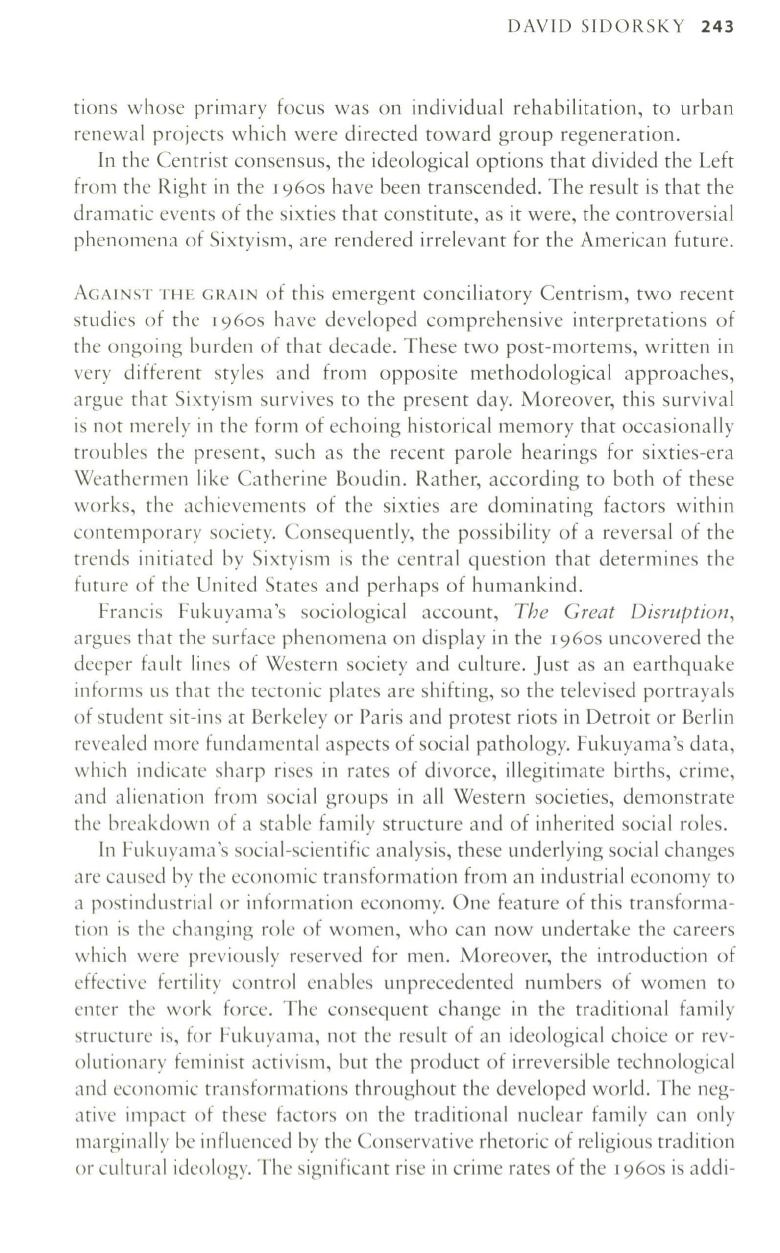
DAVID SIDORSKY
243
tions whose primary focus was on individual rehabilitation, to urban
renewal projects which were directed toward group regeneration.
In the Centrist consensus, the ideological options that divided the Left
from the Right in the
I
960s have been transcended. The result is that the
dramatic events of the sixties that constitute, as it were, the controversial
phenomena of Sixtyism, are rendered irrelevant for the American future.
AGAINST THE GRAIN
of this emergent conciliatory Centrism, two recent
studies of the 1960s have developed comprehensive interpretations of
the ongoing burden of that decade. These two post-mortems, written in
very different styles and from opposite methodological approaches,
argue that Sixtyism survives to the present day. Moreover, this survival
is not merely in the form of echoing historical memory that occasionally
troubles the present, such as the recent parole hearings for sixties-era
Weathermen like Catherine Boudin. Rather, according to both of these
works, the achievements of the sixties are dominating factors within
contemporary society. Consequently, the possibility of a reversal of the
trends initiated by Sixtyism is the central question that determines the
future of the United States and perhaps of humankind .
Francis Fukuyama's sociological account,
The Great Disruption,
argues that the surface phenomena on display in the 1960s uncovered the
deeper fault lines of Western society and culture. Just as an earthquake
informs us that the tectonic plates are shifting, so the televised portrayals
of student sit-ins at Berkeley or Paris and protest riots in Detroit or Berlin
revealed more fundamental aspects of social pathology. Fukuyama's data,
which indicate sharp rises in rates of divorce, illegitimate births, crime,
and alienation from social groups in all Western societies, demonstrate
the breakdown of a stable family structure and of inherited social roles.
In fukuyama's social-scientific analysis, these underlying social changes
are caused by the economic transformation from an industrial economy to
a postindustrial or information economy. One feature of this transforma–
tion is the changing role of women, who can now undertake the careers
which were previously reserved for men. Moreover, the introduction of
effective fertility control enables unprecedented numbers of women to
enter the work force. The consequent change in the traditional family
structure is, for fukuyama, not the result of an ideological choice or rev–
olutionary feminist activism, but the product of irreversible technological
and economic transformations throughout the developed world. The neg–
ative impact of these factors on the traditional nuclear family can only
marginally be influenced by the Conservative rhetoric of religious tradition
or cultural ideology. The significant rise in crime rates of the
I
960s is add i-


